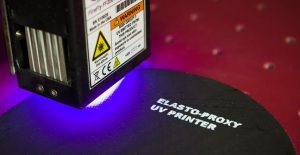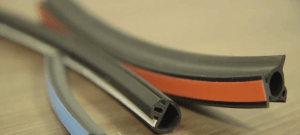
Doug Sharpe
President of Elasto Proxy
Elasto Proxy Supplies EPDM, Neoprene, Nitrile, Silicone, and Other Sponge Rubber Profiles
Elasto Proxy designs and fabricates sponge profiles made from neoprene, EPDM, nitrile, silicone and other elastomeric materials. These industrial rubber products are used for shock absorption and provide good compression and recovery. Sponge rubber profiles are softer and less resistant to compression than solid profiles, but sponge rubber has a high strength-to-weight ratio.
Sponge rubber profiles are formed via extrusion, a production method that allows rubber goods to be run in continuous lengths of the same cross-section. Extruded rubber is manufactured using chemicals and additives such as flame retardants, fillers, cross-linking agents, and pigments or colorants. Sponge rubber extrusions are categorized as either open cell or closed cell, depending on their structure.
Open Cell Sponge Rubber Permits the Passage of Air, Water, and Chemicals
Open cell sponge rubber contains interconnected pockets so that air, water, and other chemicals can pass through when the material is not compressed. Open cell sponge profiles are suitable for low-pressure and spring-action sealing, but are not recommended for weatherstripping. Additional applications for open cell sponge rubber profiles include cushioning, insulation, and padding.
Elasto Proxy supplies open cell sponge rubber products made from materials such as polyurethane, polyester, and polyether. Polyurethane sponge rubber absorbs shock and provide cushioning in packaging and furniture. Polyester sponge rubber is lightweight, mildew resistant, and has low thermal conductivity. Polyether sponge rubber is used for sound absorption and dampening.
Closed Cell Sponge Rubber Prevents the Passage of Air, Water, and Chemicals
Closed cell sponge rubber contains balloon-like cells that hold nitrogen gas and prevent the passage of air or water at low pressures. Made of versatile, flexible materials, closed cell sponge combines strong sealing capabilities with good compression and recovery characteristics. There are many applications for closed cell sponge rubber products, including military, medical equipment, and acoustic insulation.
Elasto Proxy also offers closed cell profiles made of EPT, EVA, nitrile rubber, and SBR sponge; polyethylene, polyurethane, and PVC sponge; and closed cell sponge rubber profiles that use pressure-sensitive adhesives (PSA). Neoprene and EPDM are used in many sponge rubber profiles. Silicone is suitable for high-temperature applications.
Sponge Rubber Part Design and Custom Fabrication
Elasto Proxy also provides technical design and custom fabrication services to meet your sealing challenges. Ask us how we can transform your sponge rubber profiles into sponge rubber gaskets by cutting sections to length and applying adhesive. Our water jet cutting machine eliminates tooling charges, and we can supply taped parts that use a heat-activated adhesive taping system (HATS).
How Can We Help You?
Do you need to source sponge rubber profiles? How can we help you? For more information about Elasto Proxy’s wide selection of industrial rubber products, please contact us or request a quote.
I also hope you’ll join the conversation on our social media sites. Look for a post with a link to this blog entry on LinkedIn, Facebook, Google+, and Twitter.
Finally, please you’ll subscribe to our free e-newsletters. They’re a great source of information delivered right to your email inbox, and provide links to blog entries like this one.










